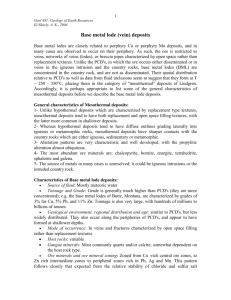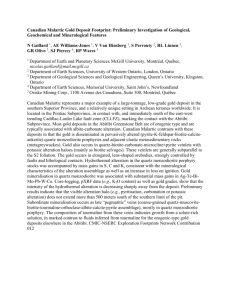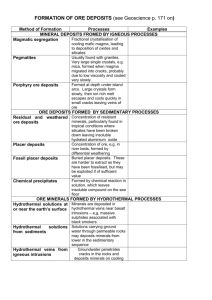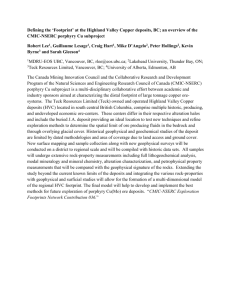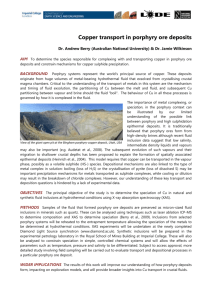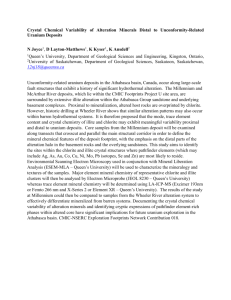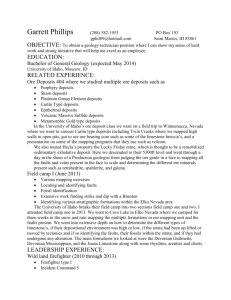Porphyry Cu deposits
advertisement
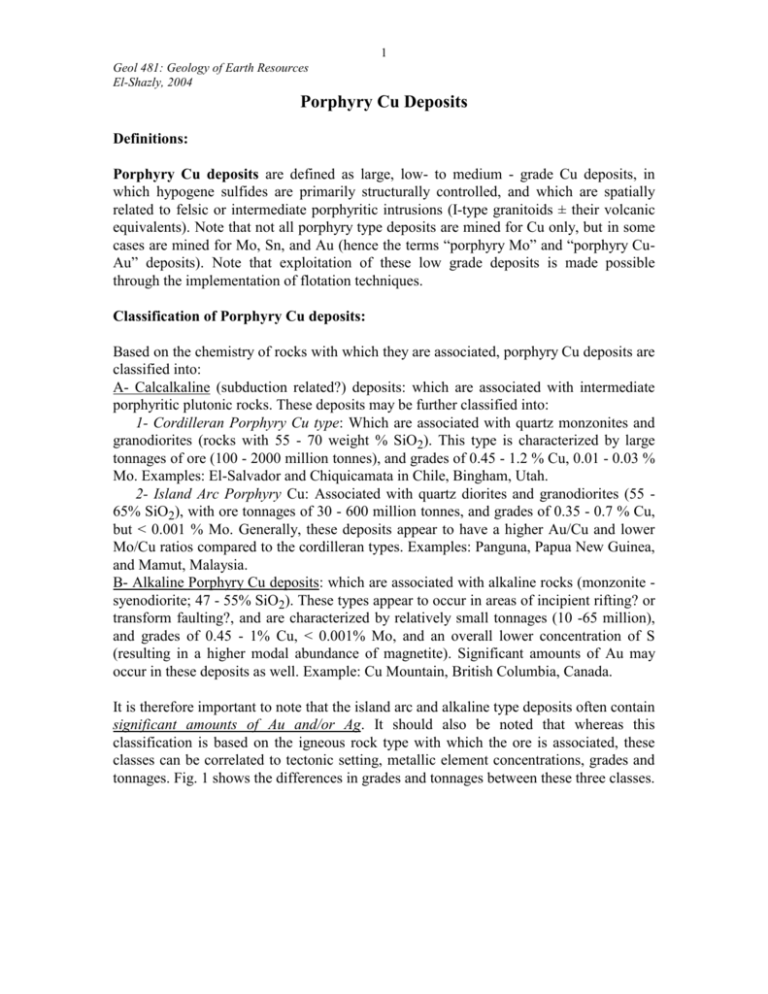
1 Geol 481: Geology of Earth Resources El-Shazly, 2004 Porphyry Cu Deposits Definitions: Porphyry Cu deposits are defined as large, low- to medium - grade Cu deposits, in which hypogene sulfides are primarily structurally controlled, and which are spatially related to felsic or intermediate porphyritic intrusions (I-type granitoids ± their volcanic equivalents). Note that not all porphyry type deposits are mined for Cu only, but in some cases are mined for Mo, Sn, and Au (hence the terms “porphyry Mo” and “porphyry CuAu” deposits). Note that exploitation of these low grade deposits is made possible through the implementation of flotation techniques. Classification of Porphyry Cu deposits: Based on the chemistry of rocks with which they are associated, porphyry Cu deposits are classified into: A- Calcalkaline (subduction related?) deposits: which are associated with intermediate porphyritic plutonic rocks. These deposits may be further classified into: 1- Cordilleran Porphyry Cu type: Which are associated with quartz monzonites and granodiorites (rocks with 55 - 70 weight % SiO2). This type is characterized by large tonnages of ore (100 - 2000 million tonnes), and grades of 0.45 - 1.2 % Cu, 0.01 - 0.03 % Mo. Examples: El-Salvador and Chiquicamata in Chile, Bingham, Utah. 2- Island Arc Porphyry Cu: Associated with quartz diorites and granodiorites (55 65% SiO2), with ore tonnages of 30 - 600 million tonnes, and grades of 0.35 - 0.7 % Cu, but < 0.001 % Mo. Generally, these deposits appear to have a higher Au/Cu and lower Mo/Cu ratios compared to the cordilleran types. Examples: Panguna, Papua New Guinea, and Mamut, Malaysia. B- Alkaline Porphyry Cu deposits: which are associated with alkaline rocks (monzonite syenodiorite; 47 - 55% SiO2). These types appear to occur in areas of incipient rifting? or transform faulting?, and are characterized by relatively small tonnages (10 -65 million), and grades of 0.45 - 1% Cu, < 0.001% Mo, and an overall lower concentration of S (resulting in a higher modal abundance of magnetite). Significant amounts of Au may occur in these deposits as well. Example: Cu Mountain, British Columbia, Canada. It is therefore important to note that the island arc and alkaline type deposits often contain significant amounts of Au and/or Ag. It should also be noted that whereas this classification is based on the igneous rock type with which the ore is associated, these classes can be correlated to tectonic setting, metallic element concentrations, grades and tonnages. Fig. 1 shows the differences in grades and tonnages between these three classes. 2 Geol 481: Geology of Earth Resources El-Shazly, 2004 Characteristics of Porphyry Cu Deposits (PCD): Size, tonnage and grade: PCD's are characterized by their very large sizes (several km2 in outcrop) and tonnages, and are therefore often mined by the open pit method. The grade is low to medium (< 1% Cu), with other by-product elements with 0.6 - 0.9% Cu equivalent ranges. Geological environment: From the above classification, PCD's are associated with linear belts of magmatic activity (subduction related?). Host Rock type: A variety of intermediate plutonic to volcanic rocks, all of which are characterized by a porphyritic texture. There is a close relationship between the host rock type and the type and concentration of the metal extracted. This suggests that these igneous host rocks are the most likely source of the metal (and not the intruded country rock). Spatial distribution of the ore: The ore deposits are associated with small plutons (< 1.5 km in diameter), and concentrate in their top parts (i.e. at shallow depths of 1 - 5 km). In addition to occurring in the igneous rock, ore minerals may also occur in the intruded country rocj alone, or in both the igneous rock and its host country rock. The ore body itself (mineralized horizon) often occurs as steep walled cylinders (Fig. 3) arranged in a concentric fashion around (and within) the intrusion. Some deposits have breccia zones and pipes. Mineralogy of the Ore: Chalcopyrite is the most important ore mineral in PCD's. Bornite and chalcocite, with higher metal Cu contents are rare or absent. In porphyry Mo deposits, molybdenite is the most important sulfide. Although these sulfides tend to concentrate within specific parts of the igneous intrusion (mainly the top parts), they occur disseminated in these rocks, as well as in the country rocks. However, it should be noted that many PCD's are "surrounded" by one or more "zones" of vein networks or stockworks that are often mined for other elements (e.g. Au, Ag, Pb, Zn, Bi, ...etc; see "Cordilleran base metal lode" type deposits). Figure 2 shows the relationship between vein abundances and distance from the main plutonic body. Alteration patterns: Alteration patterns are among the most characteristic features of PCD's, that the "idealized" or "model" spatial and temporal relationships between the various types of hydrothermal alteration are to a large extent well represented by most PCD's (especially the Cordilleran type). Moreover, there is a very close spatial and temporal relationship between the alteration patterns and the zonation of ore minerals (Table 1). This relationship strongly suggests that PCD mineralization and wall rock alteration are indeed genetically related. 3 Geol 481: Geology of Earth Resources El-Shazly, 2004 In general, from core to rim, alteration patterns for PCD's follow the zonal sequence: Potassic sericitic propylitic argillic, with the latter zone usually restricted to shallow depths (Figs. 3 and 4). Figures 3 and 4, which show the relationship between the different alteration zones and the corresponding zones of sulfide mineralization, also show that the ore minerals occur in disseminated form in the zone of potassic alteration, but in the sericitic zones, they also occur in veinlets. As pointed out earlier, the abundance of veins and veinlets increases towards the periphery of the intrusion, where structural control over the distribution of the ore minerals becomes important. This zonal distribution of minerals marks the gradation from the PCD's to the Cordilleran base metal lodes which will be described later. These veins and veinlets vary in size and type, often exhibiting a variety of interesting crosscutting relations, and could be of the open space filling or replacement types (Fig. 5). Ore mineral zonation: The zonal distribution of ore minerals follows closely the wall rock alteration zones: 1- The potassic zone: is characterized by the minerals bornite, chalcopyrite and magnetite, with cp > py. Textures suggest that magnetite was replaced by cp and bn. 2- The sericitic zone: contains pyrite, chalcopyrite ± tennantite ± sphalerite, with py > cp. Textural relations suggest that py formed at the expense of magnetite ± chalcopyrite (by sulfidation). 3- The argillic zone, representing the zone of supergene enrichment, contains the minerals chalcocite, pyrite, or covellite + py, depending on the intensity of alteration. Table 1 shows the relationship between the sulfide assemblages and the wall rock alteration patterns (where five different zones have been identified). Temporal sequence of mineralization and wall rock alteration: From the above discussion, it is obvious that the potassic alteration is the earliest, taking place at the highest temperature (500 - 350°C), and was effected by hypogene fluids. This alteration was possibly contemporaneous with some sort of propylitic alteration taking place in the periphery of the body at considerably lower T (T< 400°C). Sericitic alteration then followed, taking place at T between 250 and 320°C, and was superimposed on the potassic zone in some parts. The latest types of alteration are the argillic or advanced argillic types, which were superimposed on the sericitic zone (Figs. 3 & 4; Table 1). This temporal sequence can be explained with the help of a Hemley - type diagram (Fig. 6), where the shaded areas labelled I through V represent the different alteration zones identified in Table 1. This diagram shows the compositional evolution of the hydrothermal fluids. In order to understand the ore mineral zonation and the relationship between the different sulfides, we must first use a compositional phase diagram as the Cu - Fe - S ternary (Fig. 7). Tie lines on this diagram represent ore mineral assemblages observed in the different zones of a PCD; namely: cp + bn cp cp + py (all in the potassic zone) py + bn + cc py + cc py + cv + cc (sericitic and argillic zones). 4 Geol 481: Geology of Earth Resources El-Shazly, 2004 Reactions marking the transition from one zone to another can therefore be identified with the help of this diagram (and in many cases are supported by textural observations). If these reactions are then plotted on a log fS2 vs T diagram (Fig. 8), it can be seen that this zonation is the result of increased sulfidation from the core to the margin of the PCD. Age and regional distribution: Almost all PCD's are restricted to the Phanerozoic, with most deposits formed during the Mesozoic and Cenozoic eras (i.e. 200 m.y. or younger; Fig. 9). A sharp increase in the number of PCD's is recorded in post-Jurassic rocks, and appears to coincide with the breakup of continents and the increase in the incidence of subduction. On a regional scale, PCD's appear to be almost restricted to three major "belts": (i) the southwestern Pacific belt, (ii) the Alpide belt, and (iii) the western Americas Belt. All three belts seem to have formed or developed by the process of subduction. Origin of PCD's: The characteristic features of PCD's, and especially their spatial and temporal association with subduction-related rocks indicate that subduction played a major role in their formation. The facts that PCD's always occur in calcalkalic to alkalic porphyritic rocks, and that the metal concentrations tend to vary with variations in the chemistry of the igneous intrusion suggest that these igneous rocks are the most likely source of the metal, and not the intruded country rock. The porphyritic nature of the igneous rocks, requiring two stages of cooling, also leads to the conclusion that quenching and exsolution of fluids from the magma (resulting from a sudden drop in P and T) were among the factors which led to the development of this hydrothermal system. This itself is also supported by the stockwork/ disseminated nature of the ore, and the presence of breccia pipes (crackle breccia). Based on these features and conclusions, and on the temporal relations between the various types of alteration, models for the origin of PCD's include three stages: (i) An early magmatic fluid stage (at T: 700 - 550°C, and lithostatic pressure), in which hypogene ore minerals form by a specialized crystallization history and fO2 changes (cf. Evans). Cu content is somehow increased by the fractionation of magnetite and augite from the calcalkaline magma. With ongoing fractionation, PH2O exceeds the confining pressure (or strength of the rock cap), resulting in some explosive volcanism (and brecciation), and a subsequent drop of PH2O, which in turn results in retrograde boiling. Fluids separating from the magma then circulate to greater depth and scavenge the Cu from the crystallized igneous rock. Potassic alteration is a product of this stage, and is associated with some secondary injection. (ii) A superimposed meteoric water stage which led to sericitic alteration, and which remobilized (and concentrated?) some of the sulfides. This results in the overall increase in the amounts of hydrothermal fluids, hence increasing their capability to leach more Cu from greater depths. A change in the chemistry/ T of the hydrothermal fluids results in the 5 Geol 481: Geology of Earth Resources El-Shazly, 2004 precipitation of the Cu as chalcopyrite at the boundary between the two hydrothermal cells (between the potassic and sericitic zones). (iii) A late stage of convective circulation of groundwater resulting in argillic alteration which may have led to supergene enrichment of the ore deposit. Figures 10 and 11 show the stages of evolution of two porphyry type deposits: the El-Salvador PCD of Chile (Fig. 10), and a porphyry tin deposit (Fig. 11).

